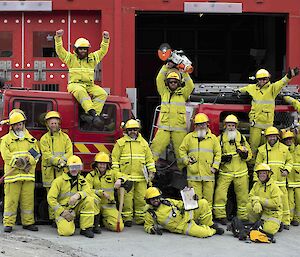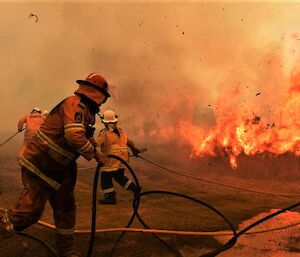The 2020 season at Mawson saw one of the most benign periods of firefighting ever experienced on an Antarctic station, mostly due to the diligent custodianship of a group of highly-trained, courageous and dedicated individuals.
The Mawson Station Fire Team for the past season consisted of the top 90% of the station’s expeditioners. The selection process occurred over four days at the Tas Fire training facility south of Hobart, in early January 2020. To pass the first and most contentious stage of selection, expeditioners were required to nominate whether or not they intended to shave their beard, and thus, qualify to potentially be one of the eight BA (Breathing Apparatus) members on the team. This was no small ask for 18 of the group, especially when the intention over the coming season was to end up looking like Gandalf the Grey before returning home in 14 months time. Two expeditioners fell out of the running at this point.
The next stage of the process saw our station leader Matt drop out of contention, on account of being the incident controller – the person who is required to make sure everyone musters after an alarm, and is not still asleep in their room, on fire. Our doctor Frank was the next to be ruled out, as he is potentially required to treat the person who was still asleep in their room, on fire. And finally, our field training officer Mark rescinded his nomination for a position, due to the fact that he’s a pyromaniac, and putting out fires is against his moral code.
Thus, what remained was the best of the best. The cream of the crop. The tip of the spear. A group ready to charge into a burning building without care for their own safety, or even really knowing what they are doing. No fire was too intense, no victim out of reach, no ladder too high – provided the fire was confined to a stovetop on the ground floor of an abandoned cubby house.
The first day of training covered fire theory - everything from fire extinguisher types to the mechanics of combustion. Primed for some realistic practice, we were then thrown into three days of practical exercises, where teams were required to respond to a variety of scenarios, including a vehicle fire, missing persons, and various building fires. By the end of the four days, our trainers were so impressed with our cohesion as a team and our firefighting aptitude, that they declared we were the best team to have ever passed through their program, and our talents were wasted as tradespeople, chefs, communication technicians, field training officers and weather observers.
Over the course of the season, the Mawson fire team participated in monthly training exercises, which kept our skills up to speed throughout the 14 months.
Unfortunately however, the season itself (with 2 weeks to go) held no actual fire emergencies in store for us. The closest we came to pulling the pin from an extinguisher were a few false alarms activated by plasterboard dust, a faulty pressure sensor, and meltwater leaking into a fire panel. There wasn’t even a kitten stuck in a tree in need of rescue (the complete absence of both kittens and trees at Mawson notwithstanding). Not even our Field Training Officer’s propensity to watch the world burn was enough to give us a real emergency.
But on the flipside – everyone’s beards have been on point.
Hamish Stirling – Fire Chief
Footnote: the following photos include (a) the Mawson fire team, (b) a hypothetical scenario of what we probably would have looked like responding to an actual fire and (c)-(f) various sceneries, because nothing like (b) actually happened.








